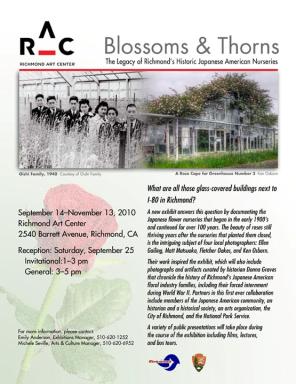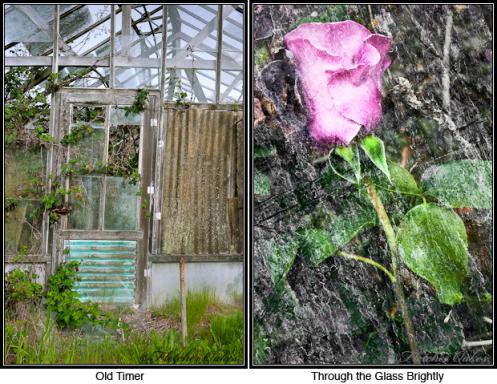Exhibit to shed light on Japanese internment, East Bay life
By Laura Casey
Contra Costa Times
Posted: 09/10/2010 03:35:53 PM PDT

Like many who drive through Richmond on Interstate 80, artist Matthew Matsuoka had long been curious about the rickety, glass-covered buildings next to the Cutting Boulevard exit.
So Matsuoka, a painter and photographer who documents historical and abandoned Richmond sites, did some research. Turns out, those buildings along the freeway were former Japanese-American-owned greenhouses with a rich history. Moreover, they were about to disappear soon, slated for redevelopment by the city of Richmond.
For Matsuoka, the story had a bit of personal touch, too. He's a Japanese-American, and his family knew some of the families who ran nurseries in the area.
"It was a small community," he said.
Matsuoka's haunting and mesmerizing images are part of a new exhibit at the Richmond Art Center titled "Roses & Thorns: The Legacy of Richmond's Historic Japanese American Nurseries." The show, which opens Sept. 14 and is the first to celebrate the art center's 75th anniversary, not only features 55 contemporary images shot at the location but offers a rich history lesson about the Japanese-Americans in Richmond.
Matsuoka spent months shooting photos at the location, a dangerous task. The area is unkept and danger seemed to lurk around nearly every corner.
"It's a difficult place to photograph because you can get hurt badly if you're not careful," Matsuoka said. "There's a bunch of broken glass and the buildings aren't stable. If you have allergies, it's one of the worst places to be."
In addition to Matsuoka, other artists contributing images of the building and surviving flowers are Ellen Gailing, Fletcher Oakes and Ken Osborn.
While the artistic portion of the exhibit is fascinating, so is the historical angle.
Curated by independent historian Donna Graves, who was instrumental in getting the Rosie the Riveter-World War II Home Front National Historic Park project off the ground, the exhibit includes historic photos and artifacts.
According to a paper by Graves, the first Japanese nursery in Richmond was established early in the 20th century. A network of nurseries grew up along the Richmond, El Cerrito and San Pablo boundary because the area offered inexpensive land with water readily accessible. In the following years, Japanese immigrants and Japanese-Americans dominated the Bay Area flower industry by cultivating small, inexpensive urban plots and using the unpaid labor of family members. They offered high quality, highly priced cut flowers.
"It allowed them to get a toehold in the U.S.," Graves said. "It's an important part of immigrant history in the West and statewide history."
World War II dramatically changed the fortunes of the hardworking flower growers, Graves said. Some growers were forced to sell their holdings. By May 1942, the entire Japanese community living in Richmond had been shipped off to Tanforan Assembly Center in San Bruno. Many were then sent to camps elsewhere in the country.
Flora Ninomiya, the 75-year-old daughter of a grower, was 6 years old when she was sent to an internment camp. Separated from her father, she, her mother and her siblings lived in a camp for more than four years.
She likes to consider the good that came out of living in that camp.
"It was the first time my mother could be involved with her family and not be part of the nursery work," she said, standing at the old nursery site.
Then she grew a bit quieter.
"But the idea we were placed in prison camps was not good," she said. "My mother was an American citizen. I never want to see that happen again."
Ninomiya's family was fortunate. A neighbor ran the family's nursery and paid their property taxes so they wouldn't lose their home during the internment. When the war was over, they came back to work and a place to live. Not all Japanese immigrants were as lucky.
The show, along with events at El Cerrito City Hall and the Richmond Museum of History, is meant to bring out stories such as Ninomiya's.
"To marry these beautiful and painful images with this story that is both bitter and hopeful of the American dream is, I think, a wonderful way to recognize this legacy," Graves said. "It's got a power that a couple of sentences in a textbook don't communicate."
if you go
WHAT: "Roses & Thorns: The Legacy of Richmond's Historic Japanese American Nurseries"
WHEN: Sept. 14 -- Nov. 13
WHERE: Richmond Art Center, 2540 Barrett Ave., Richmond.
HOURS: 11 a.m.-5 p.m. Tuesday-Saturday
ADMISSION: Free
EVENTS: Reception, 3 to 5 p.m. Sept. 25. A talk with historian Donna Graves will be held at 1 p.m. Oct. 16. Bus tours will also be scheduled.
DETAILS: 510-620-6772; www.therac.org
Related exhibits
· "One Small Story from Richmond's Hidden History, Japanese-American Nurseries," will be on exhibit from Sept. 12 to Oct. 24 at the Richmond Museum of History, 400 Nevin Ave., Richmond. Hours are 11 a.m. -4 p.m. Wednesdays -Sundays. 510-235-7387, www.richmondmuseumofhistory.org.
· "Remembering Our Local Japanese Heritage: Nursery Photo Exhibit" is on display now until Oct. 7 at El Cerrito City Hall, 10890 San Pablo Ave., El Cerrito. Hours are 8 a.m.-4 p.m. Mondays, Wednesdays and every other Friday and 8 a.m.-6 p.m. Tuesdays and Thursdays. 510-215-4318, www.el-cerrito.org.
Richmond Art Center
Blossoms & Thorns
The Legacy of Richmond’s Historic Japanese American Nurseries
Featuring Richmond-based photographers Ellen Gailing, Matthew Matsuoka, Fletcher Oakes and Ken
Osborn. Curated by Emily Anderson and Donna Graves.
Dates: September 14 – November 13, 2010
Reception: September 25 Invitational: 1-3 pm
General: 3 - 5 pm
Public Programming:
October 16 1 - 3 pm
Blossoms and Thorns: Richmond’s Japanese American Nurseries and their Legacy
A talk with historian Donna Graves and filmmaker Kenneth Kokka. who will
screen his award-winning film, The Chessmen, shot at the Sakai nurseries.
Additional Programming:
Film Screenings
Bus Tours conducted by the National Park Service
Dates TBD – call 510-620-1252 or 510-620-6952 for updated info
Blossoms & Thorns: The Legacy of Richmond’s Historic Japanese American Nurseries is an exhibition of
contemporary and historic photographs and artifacts exploring the Japanese American cut flower nurseries that
began in Richmond in the early 1900’s and continued for over 100 years despite various challenges including
internment during World War II.
The contemporary photos are the inspiration for this exhibition. While the buildings fell into disrepair, the roses
and carnations continue to thrive and often are found bursting through the roofs and windows. The contemporary
photographers’ images document the beauty of these “ruins,” as well as the profound tenacity of the plants and
the significance of the years of work that cultivated them.
The exhibition also explores the remarkable legacy of Japanese Americans who built a thriving community and
flower industry in Richmond beginning over a century ago. During WWII these families were forced into
internment camps and had to leave their properties, businesses and homes behind. In a few cases they were able
to pass them on to others to run for them until they could return. Several of the family businesses were able to
rebuild and continued for many years after the war despite additional encroachments by the construction of
Highway 80 and BART. Eventually, federal policies that favored flowers imported from Latin America caused this
once vital industry to lose its viability and the businesses were shut down. Richmond holds the last extensive historic
flower nurseries built by Japanese Americans in California, but they will soon be demolished to make way for affordable housing.
“These nurseries are a rare legacy of an important chapter in Japanese American history and in the heritage of our
state.
Preserving California’s Japantowns’ surveys of Nikkei communities across California did not identify any
other sites that hold this depth and breadth of historic connection to the Japanese American flower-growing
industry,” states Donna Graves, historian and director of the project, Preserving California’s Japantowns. Graves is
the curator of the historic portion of this exhibition. She has written extensively about the Richmond nursery
community and initiated a video documentary project about Richmond’s Japanese American heritage that is
currently underway.
Collaborators:
City of Richmond’s Arts and Culture Division; Susan Sharfman, Richmond resident; Tom Panas, El Cerrito Historical
Society; Natalia Lawrence, Community Redevelopment Agency, City of Richmond; Monique A. le Conge, Director
Library & Cultural Services; Donna Graves, Historian/Arts and Culture Planner; Morgan Smith, Tom Leatherman, and
Betty Soskin: National Park Service - Rosie the Riveter/WWII Home Front National Historical Park.
Nikkei Advisors Charlotte Sakai, Marjorie Fujioka, Jill Shiraki, Flora Ninomiya, Joan Matsuoka, Chizu Iiyama, Barbara Saito,
Jim Oshima and Larry Oishi.
Venue:
Richmond Art Center
2540 Barrett Avenue (entrance at 25th Street)
Richmond, CA 94804
510.620.6772 ~ www.therac.org
Gallery Hours: Tuesday – Saturday, 11:00am – 5:00pm
All exhibitions and events free and open to the public
Galleries are wheelchair accessible. Free and abundant parking.
Description: The Richmond Art Center inspires active engagement in the visual arts through exhibitions, education, and in-school
programs as the San Francisco Bay Area’s longest established art center. Artists involve children and youth in the creative process
through residencies in public schools, and instruct individuals of all ages through studio classes and workshops. Exhibitions
introducing contemporary Bay Area artists and community-based projects reflect the richness and diversity of the region.
